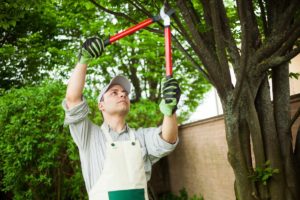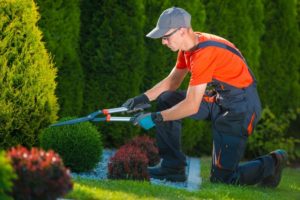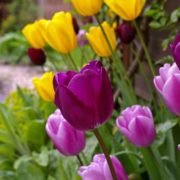Spring trimming and pruning
April 2018
With the arrival of spring comes warmer weather which leads to the reawakening of the trees, plants and shrubs in our yards. And with that comes the question of what to prune, what not to prune and when to prune. Purdue Extension Services calls pruning “one of the best, worst maintenance practices” performed on trees and shrubs. The process creates wounds, which have a major impact on the processes of the plant. Improperly cutting a tree or plant can cause damage and even death of the plant or tree. So pruning properly is important.
There are lots of reasons to prune. The Tree Care Industry Association (TCIA) says proper pruning encourages strong growth, increases flower and fruit production, improves plant health, and removes damaged limbs. All of these things also make the tree or shrub more attractive too. However, you must prune at the right time and in the right way. If you do not, it is possible you could kill your plants and trees. The TCIA lists a few main reasons to prune your trees:
• Reduce risk of failure from dead or weak branches
• Provide clearance
• Reduce shade and wind resistance
• Manage tree health
• Manage flower or fruit production
• Improve aesthetics
• Improve tree structure
• Save a storm-damaged tree
Do’s and Don’ts from the TCIA
DO:
• Remember that poor pruning can cause damage that lasts for the life of the tree.
• Assess your trees after a storm to see if there is pruning needed.
• Ask your arborist or tree care company if they prune according to the American National Standards Institute standard for tree pruning. This means they use certain tools, cutting techniques and pruning methods. And, in fact, estimates for pruning should be written according to these standards.
DON’T:
• Prune without a good reason
• Remove any more than 25 percent of foliage during a growing season.
• Prune a newly planted tree for the first year, unless you are removing dead or broken branches.
• Prune within 10 feet of a utility conductor – call a pro!
• Try to tackle a pruning job that requires a chain saw and ladder work – again, call a pro!
• Leave branch stubs, or cut off the branch collar
• Climb the tree with climbing spikes
• Use wound paint
• Strip out inner foliage and branches
When to prune
The TCIA says winter is a good time to prune because trees are dormant and winter pruning encourages new growth in the spring. Have it done when the coldest part of winter is over.
Spring blooming trees should be pruned once their flowers have faded. Mid to late summer blooming trees should be pruned in late winter or early spring.
Summer pruning slows down the growth of branches you don’t want and it’s easier to see problems when the growth cycle has slowed down.
Fall is typically not a good time to prune. Trees heal more slowly from pruning leaving them susceptible to fungi in the air.
Pruning trees
 According to Better Homes and Gardens, pruning trees is necessary at certain times during a tree’s life. Pruning young trees encourages strong natural forms and leads to less work for you later in their lives.
According to Better Homes and Gardens, pruning trees is necessary at certain times during a tree’s life. Pruning young trees encourages strong natural forms and leads to less work for you later in their lives.
However, you should not prune a newly planted tree unless it has damaged or dead branches. Give it a year to establish itself before pruning. Then over the next few years, you should prune every year to remove poorly positioned branches such as crossing or competing branches and help the tree develop its ideal form.
Established trees need occasional pruning to remove dead branches. If the tree has been neglected, it may be necessary to control its size, reduce excess shade, or prevent branches from rubbing against each other, wires, buildings, or vehicles.
As a rule, cut no more than one-fourth of the tree’s branches in one year. If a tree needs extensive renovation, spread it out over two or more years. Cutting more than 25 percent of any tree’s branches can damage the tree.
If you have a large more mature tree that needs pruning or trimming there are guidelines. Remove a branch too large to hold in one hand with three separate cuts, using a bow saw. Make the correct cuts using a three-step process instead of trying to do it in one cut. Doing it in one cut can rip the bark from the tree causing damage to the tree. You should also avoid leaving a stub, which will, over time, decay and may allow pests to invade the tree.
Rules of thumb for pruning plants and shrubs
According to Better Homes and Gardens a good place to start pruning any plant is to remove dead, diseased, or damaged stems as soon as you see them. Dead stems attract insects and invite diseases. Also remove crossing branches, water sprouts (vigorous upright growing shoots that form on trunks or side branches), and suckers (vigorous shoots that develop near or from below ground).
Better Homes and Gardens provides rules of thumb for pruning various types of plants and shrubs:
Spring-Flowering Trees and Shrubs
Early-spring bloomers, such as lilac, forsythia, and rhododendron, bear flowers on wood formed the previous year. The best time to prune them is late spring, right after they finish blooming. If you prune them later in the growing season or during winter, you’ll remove flower buds and decrease the amount of spring bloom.
Better Homes and Garden Tip: To keep spring bloomers flowering vigorously, remove some of the oldest shoots all the way to the ground. This allows younger stems to grow and bloom.
Summer-Blooming Trees and Shrubs
Plants that bloom in summer, such as potentilla, butterfly bush, and crape myrtle, produce their flowers on new growth from the current season. Prune them in winter while they’re dormant, or in early spring just before they push out their new growth. You can even cut them all the way to the ground in late winter, and they’ll still bloom that same summer.
Hydrangeas
The first most important thing with hydrangeas is knowing what type you have. Most hydrangea types, whether it’s pink, blue, or white mopheads and lacecaps, or oakleaf forms, bloom on old wood. So these should be pruned before midsummer. If you prune them in winter or early spring, you’ll be removing flower buds.
The newer re-blooming types, such as the Endless Summer Series or Let’s Dance Series, which bloom on new growth as well as old wood, do not have a pruning timing issue. If you cut off some of the flower buds by pruning the old stems, the plant will bloom on the new growth.
White-flowered paniculata and arborescens types of hydrangea, flower on new wood, so they can be pruned any time other than just before they bloom.
Foliage Shrubs (NO Showy Blooms)
Shrubs such as Barberry and Burning Bush that are grown for their foliage can be pruned almot antime except in late fall. Any major pruning on such shrubs should be done in winter when the bush is dormant.
Hedges
Shrubs such as boxwood and privet are often used as a hedge and are sheared. To keep the hedge solid, shear the bush frequently during the early part of the growing season. Keep the top narrower than the base so that the upper branches don’t shade the lower ones. Stop shearing the hedge approximately six weeks before your area’s average first frost.
Roses
Climbers and garden roses that bloom once a year should be pruned after they finish blooming. Repeat bloomers are pruned to shape the plant or to remove any winter damage.
Deciduous Shade Trees
Prune shade trees such as oak, linden, and ash when they are dormant in winter.
Deciduous Fruit Trees
Apples (including crabapples), peaches, pears, plums, and cherries should be pruned in midwinter.
Broadleaf Evergreens
Most broadleaf evergreens, including holly, mahonia, and some types of magnolias, need little pruning. The best time to prune them is in early spring, just before they put on their growth spurt. You can do minor shaping and pruning at other times of year, too.
Needle-Leaf Evergreens
Most trees and shrubs with needlelike or scalelike foliage (spruce, juniper, cypress, arborvitae, fir, yew, Douglas fir, and false cypress) are best pruned early in the growing season. Avoid cutting back into wood that has no green needles; it may not sprout new growth.
Pines
Prune pines only in the candle stage, before the new shoots turn woody and before the needles have fully expanded. Prune only a portion of the new growth.
Perennial Flowers
Perennial flowers look best if you remove faded flowers. This is called deadheading. If your perennial flowers become too tall or flop open in the middle, try shearing them back to 6-12 inches above the ground.
Annual Flowers
Deadhead annual flowers regularly to keep them blooming well.
PRUNING SAFELY
Pruning can be dangerous so you must use common sense while pruning and use the right equipment. Better Homes and Gardens offers guidelines to follow.
Dress appropriately for pruning, wearing long pants, long-sleeved shirt, gloves, safety glasses, and nonskid shoes. A brimmed hat keeps the sun from obscuring your vision.
Keep tools sharp and clean. Store a sharp tool in a protective sheath, if possible. Carry pruning tools with the points facing down. Choose a clear, still, dry day for pruning.
If you must prune from a ladder, tie it securely to the tree. Keep one hand on the ladder and one hand on your pruning saw. And station someone on the ground to help secure the ladder.
THE RIGHT WAY TO PRUNE
Better Homes and Gardens offers simple guidelines to avoid common pruning mistakes and points out that pruning isn’t complicated if you follow some basic principles. These guidelines are true for pruning either trees or shrubs.
Choose the Right Tool
Always use clean, sharp tools. Select the right-size tool for the branch you will prune to avoid damage to the plant and the tool. Use a pruning saw on branches larger than 1 to 1½ inches in diameter. Pruners work best on the smallest branches. Use loppers on branches an inch or so in diameter.
Choose the Right Time
There isn’t a single best time for pruning. Late winter is an ideal time for pruning many trees and shrubs because they are dormant and it is easier to see what needs to be pruned.
Late-winter pruning promotes fast regrowth in spring. There are exceptions, such as Oaks and crabapples which should be pruned in winter while they are dormant to keep diseases and insect from invading. Some trees, such as maples, birches, and magnolias, bleed sap heavily if pruned in late winter. This causes little harm but can be avoided by pruning these trees after they are fully leafed out in late spring or early summer.
Summer is the best time to remove dead branches when they stand out. Prune spring-flowering trees and shrubs right after they finish flowering in spring.
Trees and shrubs that bloom during summer and into fall are best pruned in later winter or early spring as soon as their annual growth begins.
Try not to prune in fall because it stimulates new growth that could be killed by winter cold.
Foliage such as suckers; water sprouts; branches that are dead, diseased, or damaged can be pruned anytime.
Choose the right cuts
Holding the thinner, upper cutting blade nearer to the trunk or main stem, make a clean cut without tearing the bark. Avoid leaving a stub, which is unsightly and provides an entry point for pests and diseases. Cut just outside the branch collar, the swelling where the branch begins.
You should always disinfect the shears and tools that you use between pruning jobs. Rub the blades with a disinfectant. This helps to prevent the spread of disease.
In Summary
Pruning is important to the health and vitality of all plants, shrubs and trees. Sometimes it is best to seek out a professional to do the job properly. However, if done correctly, safely, at the correct time of year and using the correct tools anyone can be their own master gardener.





